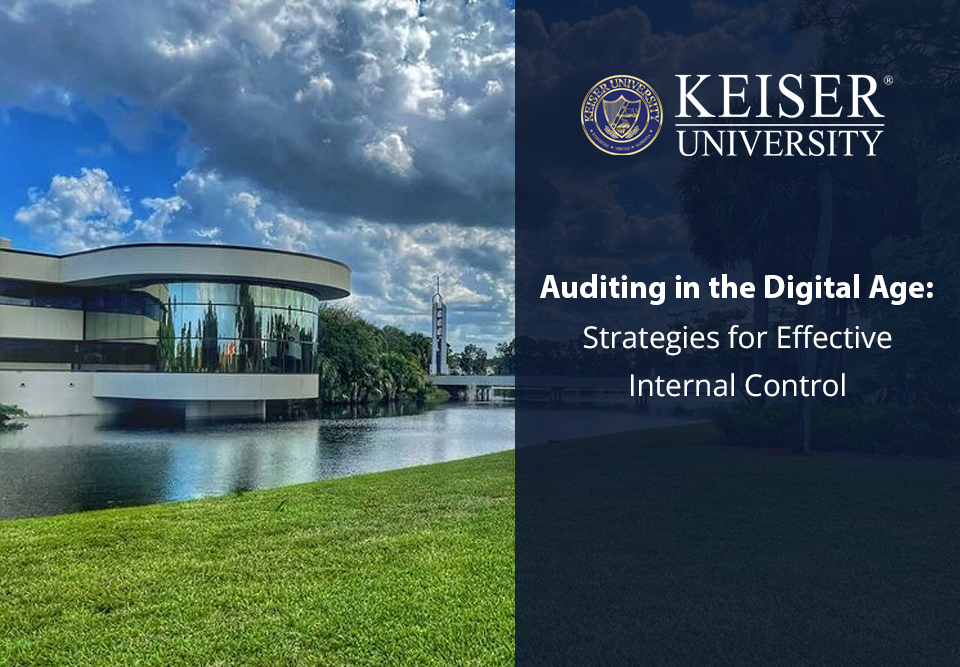Traditional auditing techniques are quickly being replaced by digital auditing strategies, making it necessary for up-and-coming accounting professionals to stay ahead of the curve. In the midst of the digital transformation, it’s essential to understand how auditing is evolving and which digital audit techniques are the most effective and reliable.
The Evolution of Auditing
Auditing is a practice that seems to have originated in ancient times, though the auditing process with which we are familiar today began to emerge in Europe during the mid-19th century. According to the CPA Journal, auditing has evolved over time to become a practice that promotes transparency and accountability within the accounting field.
Traditional vs. Digital Auditing
Traditionally, auditing was a manual process — one that was both time-consuming and tedious. Prior to advances in technology, auditors had to review financial documents, cross-reference reports and conduct auditing interviews to verify that the information in the accounts was accurate and orderly. According to the Information Systems Audit and Control Association (ISACA), technology has helped streamline the process of the internal audit, ultimately increasing the accuracy of audits and improving the speed at which they are completed.
Impact of Technology on Auditing Practices
Technology has revolutionized auditing practices in various ways, such as:
- Improving the accuracy of audits.
- Emphasizing the importance of data collection and analytics within auditing.
- Reshaping the role of the auditor.
The Role of Automation and AI in Auditing
On the surface, it may seem like automated technology will replace auditors, making the profession obsolete. However, the opposite is true: The role of automation and artificial intelligence (AI) in auditing highlights the importance of having qualified and intuitive auditors on staff. Although AI technology and machine learning may replace some of the manual task’s auditors used to perform, these technologies actually pave the pathway for a more creative future for auditors. Down the road, auditors will be more responsible for interpreting and analyzing results, developing new standards for accounting practices, implementing new technology and identifying risk areas that can help improve overall quality assurance.
Importance of Internal Control
Internal control is still critical, even amid the auditing digital transformation. While a digital internal audit can be performed quickly, its accuracy and reliability would be compromised without the proper internal controls in place.
Definition and Objectives of Internal Control
According to ISACA, internal controls are auditing processes used to verify the overall integrity of financial reports and documents as well as confirm that the organization is maintaining compliance with regulatory guidelines. Internal controls help:
- Prevent or identify financial fraud.
- Maintain regulatory compliance.
- Improve operational efficiency.
- Improve audit results.
Key Components of Internal Control Systems
The core components of internal control systems include:
- Control environment – The work environment and company culture are established by leadership and management. It is the responsibility of management to implement internal control systems that create an effective control environment.
- Risk assessment – Organizations should routinely evaluate risks and develop mitigation plans.
- Monitoring – Internal controls should be monitored regularly in order to identify any issues or risks as soon as possible.
- Communication – Clear and consistent communication is key to establishing workplace expectations.
- Control activities – Identifiable control activities help organizations maintain regulatory compliance.
- Legal and regulatory compliance – Organizations must adhere to all laws and regulatory standards for their industry.
- Separation of duties – By delegating specific tasks to different team members, organizations can reduce the risk of fraud and improve compliance.
- Physical controls – Measures must be implemented to physically protect assets. Safes, for instance, are a common form of physical control.
Benefits of Robust Internal Control
The depth and breadth of internal controls will vary significantly from one organization to the next, but developing a robust internal control system is crucial. When proper internal control systems are implemented, companies will elevate their operational efficiency while simultaneously reducing the risk of fraud.
Benefits of Digital Auditing
Digital auditing practices and strategies benefit organizations of all sizes and across all industries. Below are just a few of the benefits associated with digital auditing:
Improved Accuracy and Efficiency
Manual auditing processes are at a much higher risk of human error, whereas digital audits can be done with accuracy and precision in a matter of moments.
Enhanced Data Security
Digital audits are conducted using the most reliable and secure technology, which protects an organization’s most valuable information. In an age where cybersecurity is a top priority, the enhanced security of digital audits is particularly appealing.
Real-Time Monitoring and Reporting
Digital audits enable real-time monitoring and reporting, which can help improve overall regulatory compliance and reduce the risk of significant disruption that can result when fraud takes place.
Reduced Human Error
Traditional audits have always been performed by humans, which means that mistakes are inevitable. A digital internal audit, on the other hand, can be completed with precision using machine learning and AI technology, ultimately eliminating the risk of unnecessary errors.
Cost Savings
Digital audits involve less labor and can be completed in a shorter amount of time, making them a more affordable option for organizations.
Digital Tools for Internal Control
Auditors can use digital tools for internal control to streamline their processes and improve their reports. These are some of the most powerful digital tools for internal control:
Audit Management Software
Audit management software is heavily relied upon during the digital internal audit process. This management software provides auditors with a single platform for inputting data and generating reports, allowing them to streamline the process and enhance the accuracy of their findings.
Data Analytics Tools
Data analytics tools can be used to automatically collect data during the auditing process and quickly analyze the data to produce intuitive and relevant findings for the organization. Such tools are becoming increasingly prevalent in the digital auditing industry.
Continuous Monitoring Systems
Continuous monitoring systems allow for real-time monitoring, which helps improve risk assessment and prevent fraud. These systems are becoming a necessary technology for organizations of all sizes because they can significantly reduce the risk of fraud and help protect the organization’s assets.
Blockchain Technology
According to the ICAEW, blockchain technology is one of the most recent additions to the digital auditing industry, and auditors are still learning how to best leverage this technology to improve their processes. Blockchain technology can be beneficial when conducting an audit that includes multiple currencies, and it can help an auditor authenticate documents throughout the auditing process.
Cybersecurity Measures
Enhanced cybersecurity tools and cybersecurity measures can protect the integrity of the auditing process, ensuring that an organization’s critical financial data remains private and secure.
Implementing Effective Internal Control Strategies
In light of the digital transformation, it’s essential to implement effective internal control strategies that also leverage the leading technology available today. By prioritizing internal controls, organizations can ensure that both traditional and digital auditing practices will lead to accurate and relevant reports.
Risk Assessment and Management
Risk assessment and management is a key internal control strategy. Risk assessments help to:
- Identify possible risks.
- Showcase the impact of those risks.
- Highlight the likelihood of the risk.
- Emphasize the types of measures that can be taken to prevent or mitigate the risk.
Establishing Clear Policies and Procedures
Leadership and management should work together to create clear policies and procedures for employees to follow. By creating an environment where trust, accountability and integrity rest at the forefront of company operations, organizations can organically nurture a positive workplace culture in which employees are dedicated to the mission of the organization and willing to abide by procedures to accomplish common goals.
Training and Development for Staff
Ongoing training and professional development allow staff members at all levels to become proficient in the latest technology and familiar with the trends that are continuing to shape the industry. Investing in the employees at the organization can help improve the overall company culture and reduce the risk of fraud.
Regular Audits and Reviews
Digital auditing makes it easier to conduct regular audits and reviews, which can play a significant role in reducing the risk of fraud and elevating overall operational efficiency at the organization. Regular audits and reviews can ensure that an organization maintains regulatory compliance and provide insight into best practices that inform strategies both in the present and future.
Future Trends in Digital Auditing
While technology will continue to play a central role in digital auditing, the types of technology that auditors use in the years to come will likely change significantly. Rapidly advancing technology is sure to have an impact on the auditing field, particularly as industries across the world come to understand the true power of machine learning and AI technology.
Emerging Technologies in Auditing
According to Trullion, some of the most significant emerging technologies in auditing include:
- Robotic process automation (RPA) – RPA virtually eliminates the tedious, administrative tasks that auditors used to be responsible for. Today, auditors rely on RPA technology to complete the most tiresome tasks associated with their positions, allowing them to focus more heavily on critical and creative thinking — which can make the job substantially more rewarding.
- Blockchain technology – By allowing auditors to rely on a decentralized ledger system, blockchain technology improves the precision, accuracy and reliability of auditing reports.
Predictive Analytics
Auditors can use predictive analytics to identify risks, uncover fraud and reveal previously unseen insights, making it one of the most powerful technologies in auditing today. Predictive analytics is expected to become more essential to digital auditing in the years to come.
AI in Auditing
AI in auditing is expected to become more refined and precise, allowing auditors to leverage AI technology for specific industries. While auditors are just beginning to see the impact that AI can have on their industry, experts anticipate that AI will quickly become one of the most widely used technologies in the field.
What Is a Digital Audit? Learn More at Keiser University Graduate School
At Keiser University Graduate School, our accounting degree programs effectively prepare students for the digital transformation taking place across the industry. We offer an MBA in Accounting degree as well as a Master of Accountancy (MAcc) degree, allowing you to select the graduate degree program that best aligns with your professional interests and personal strengths. Request more information about our graduate degree programs today.






 The instructors at Keiser University impacted my life. They believed in my ability to become a great graphic designer, regardless of how I felt about my skills. KU helped to prepare me for the real world and got me to where I am today.
The instructors at Keiser University impacted my life. They believed in my ability to become a great graphic designer, regardless of how I felt about my skills. KU helped to prepare me for the real world and got me to where I am today.
